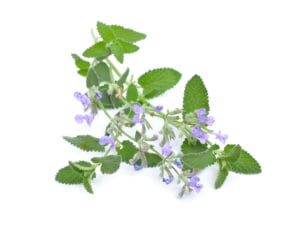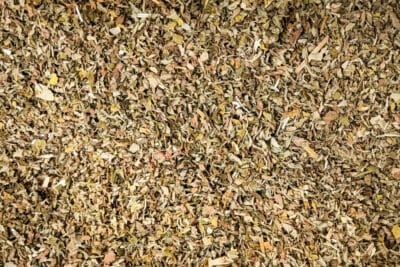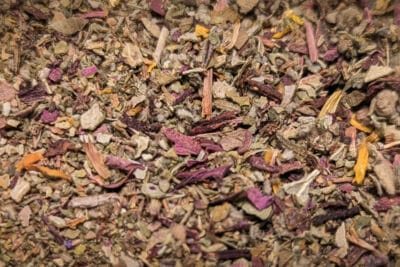Catnip – Relaxing herb
Nepeta cataria
Also referred as:
Catnip
🍃 Texture when dried
Green and yellow leaves
👅 Taste
Minty taste
❔ Usage
Herbal tea, potpourri and smoking blends
💨 Smoke
Low amount of smoke
🗜 Harshness
Moderate
⚡ Effects
Calming effect

Table of Contents
Introduction
Catnip, also known as Nepeta cataria, is a perennial herb belonging to the mint family. Often associated with its playful effect on cats, it is also highly regarded by herbal enthusiasts for its soothing properties. When used in tea or smoked, catnip can offer a mild, relaxing experience to unwind and de-stress.
Smokably products with Catnip :
-
 CatnipCAD $8.00 – CAD $12.00
CatnipCAD $8.00 – CAD $12.00 -
 The Space Within ▸ Blend from Red Lotus, Marshmallow Leaves, ColtsfootCAD $12.00 – CAD $18.00
The Space Within ▸ Blend from Red Lotus, Marshmallow Leaves, ColtsfootCAD $12.00 – CAD $18.00
Frequently asked questions
Is it common to smoke Catnip?
While it’s not as common as consuming catnip in tea, smoking catnip herb has gained some popularity among those seeking alternative smoking experiences. The herb imparts a gentle, calming effect when smoked, making it an appealing option for people looking to relax without resorting to tobacco or other substances. However, it’s essential to note that smoking any substance carries potential health risks, and using catnip in moderation is advisable.
Is Catnip smoked on its own or mixed with other herbs?
Catnip can be smoked on its own, but it is often mixed with other herbs to create a more enjoyable and diverse smoking experience. By combining catnip with herbs like chamomile, lavender, mullein, or damiana, users can tailor the blend to their desires, ranging from increased relaxation to a more vibrant sensory experience. Mixing with other herbs also helps balance out the flavor and aroma for a smoother and more enjoyable smoke. However, it’s important to be cautious when combining herbs and use them in moderation to avoid potential adverse effects.
Can Catnip help you quit smoking?
While catnip cannot directly help you quit smoking, it could potentially serve as an alternative to tobacco when trying to break the habit. Due to its calming effects when smoked or consumed as a tea, some individuals might find solace in using catnip as a substitute during their transition away from tobacco. However, it’s essential to keep in mind that the primary factor in quitting smoking is personal determination, and a medical professional or a smoking cessation program should be consulted for more comprehensive support.
Why do people enjoy Catnip ?
People enjoy Catnip for a variety of reasons.
- Calming effects: Catnip is known for its gentle, soothing properties, and people may consume it as tea or smoke it for relaxation purposes. – Aromatherapy: Its pleasant fragrance provides a delightful sensory experience, often used in aromatherapy to promote a calming atmosphere.
- Cat entertainment: Catnip is famous for eliciting playful and amusing reactions in cats, making it a popular choice for pet enrichment.
- Alternative smoking: As a non-tobacco herb, it offers an alternative smoking experience for those seeking a milder, natural option.
- Herbal blend ingredient: Catnip mixes well with other herbs, allowing users to create customized blends for various desired effects.
- Medicinal history: Although no health claims can be made, catnip has traditionally been used in herbal remedies for centuries, most commonly for digestive issues and sleep-related problems.
NB. Anecdotal or historical claims should not be construed as health claims. Always consult a health specialist prior to oral consumption of any herb. Consumption of any herbs might have side effects.
How do you make a tea out of Catnip ?
To make a herbal tea out of Catnip, you can follow these simple steps:
- Gather fresh or dried catnip leaves and flowers. If using fresh catnip, ensure that it has not been treated with chemicals or pesticides.
- Measure around 1-2 teaspoons of dried catnip or 2-3 tablespoons of fresh catnip per 8 ounces (240 ml) of water.
- Boil water in a kettle or pot, and then remove it from heat.
- Place the catnip in a tea infuser, a teapot with a built-in strainer, or directly in a teacup.
- Pour the hot water over the catnip, ensuring it is fully submerged or comes in contact with the herb.
- Steep the catnip in the hot water for 5-10 minutes. Adjust steeping time to your taste preferences; a longer steep time will result in a stronger flavor.
- If you put the catnip directly into the teacup, strain the tea into another cup to remove the herb. Otherwise, simply remove the infuser or use the built-in strainer if using a teapot.
- Optionally, you may add honey or lemon to taste, enhancing the overall flavor.
Enjoy the catnip tea while it’s warm to experience its soothing properties and pleasant taste. Make sure to consume in moderation and consult with a healthcare professional if you are pregnant, nursing, or have any health concerns.
What does Catnip look like?
Catnip (Nepeta cataria) is a perennial herb with an appearance similar to other members of the mint family. It has characteristic square stems and grows to be 20-39 inches (50-100 cm) tall. The leaves of catnip are heart-shaped with a greyish-green hue and have a soft, downy texture. They are lightly serrated on the edges and can grow up to 2-3 inches (5-7 cm) in length.
During the blooming season, which typically spans between late spring and early autumn, catnip produces small, tubular flowers that cluster in spikes at the top of the stems. These flowers are usually white or light lavender in color and have small, purple spots on their lower lip.
How has Catnip been used historically?
Historically, catnip has been used for various purposes across different cultures, primarily for its medicinal properties and as a culinary herb. Some of its traditional uses include:
- Digestive aid: Catnip was commonly used to help soothe gastrointestinal issues such as indigestion, colic, gastritis, and stomach cramps.
- Relaxation and sleep: People believed that catnip could help alleviate stress, anxiety, and insomnia. It was often consumed as tea or infused in pillows to promote relaxation and sleep.
- Cold and flu relief: Catnip tea was sometimes used to help alleviate symptoms of cold and flu, such as fever, cough, and sore throat, due to its mild diaphoretic and anti-inflammatory properties.
- Culinary uses: Catnip leaves were used to flavor soups, stews, and sauces in medieval European cooking. The young leaves were also occasionally eaten as a salad green.
- Insect repellent: The plant has been historically used as a natural insect repellent, with people planting it around their homes or hanging dried bundles to deter insects like mosquitoes and flies.
- Ceremonial and recreational use: In some cultures, catnip was used for its mild, relaxing effects during ceremonies or smoked for recreational reasons.
While catnip has been used traditionally for various purposes, it’s essential to note that no health claims can be made regarding its effectiveness, and one should always consult with a healthcare professional before using catnip or any herb for medicinal reasons.



